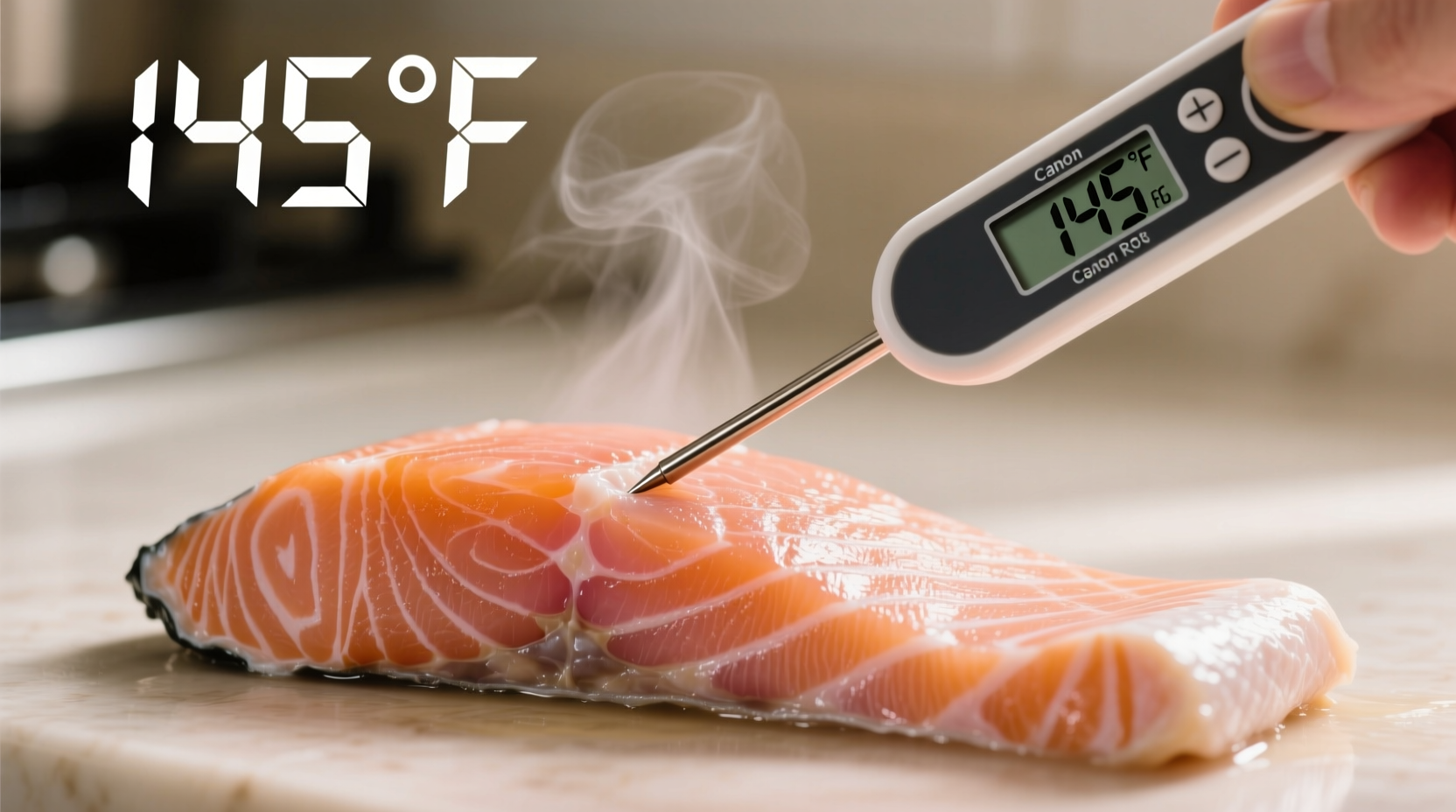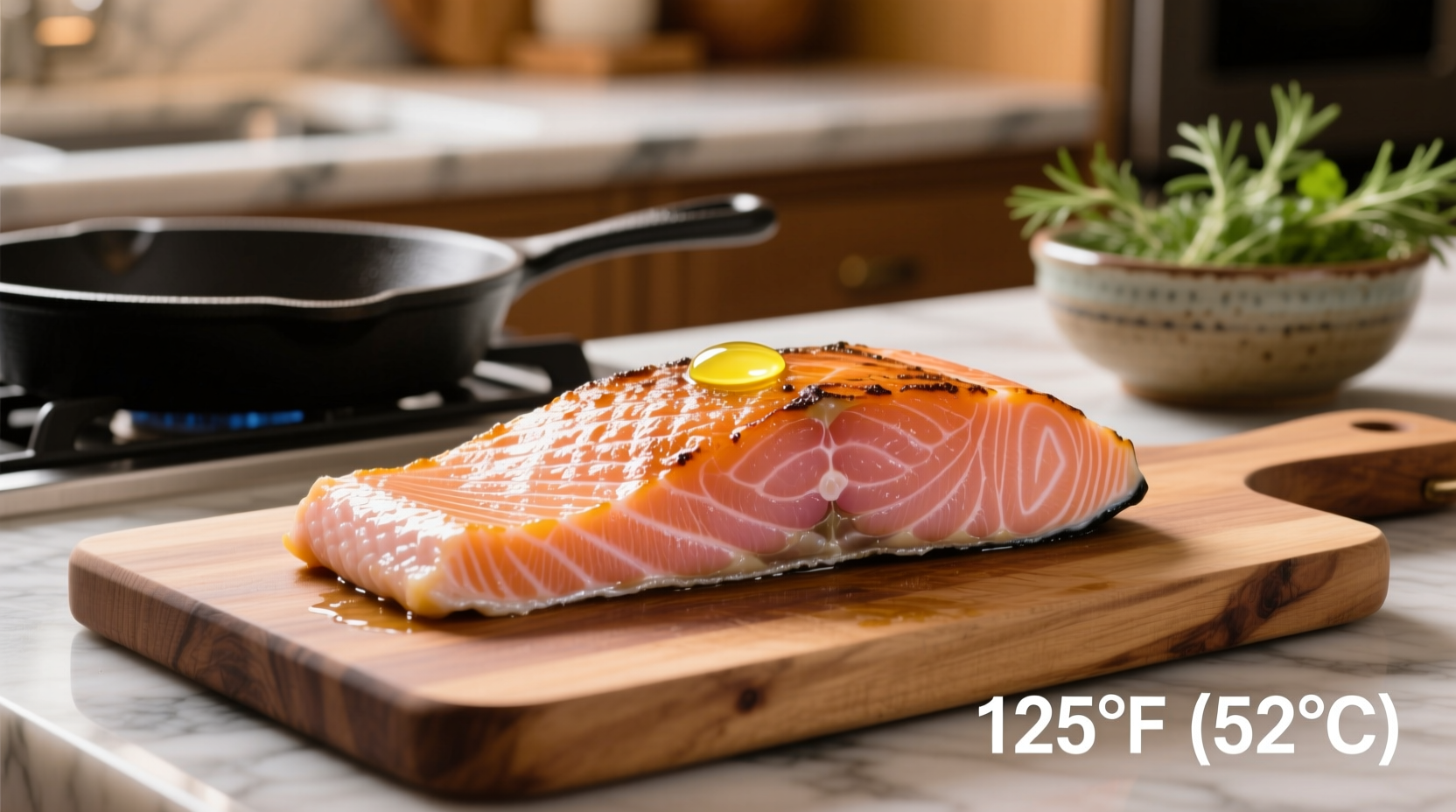Getting salmon temperature right transforms your cooking from guesswork to precision. Whether you're baking, grilling, or pan-searing, understanding the science behind the perfect doneness point prevents dry, overcooked fish and eliminates food safety concerns. Let's explore exactly how to achieve restaurant-quality salmon every time.
Why 145°F Is the Gold Standard for Salmon
The USDA's Food Safety and Inspection Service (FSIS) established 145°F as the minimum safe internal temperature for fish, including salmon. At this precise temperature:
- harmful bacteria like Salmonella and Listeria are effectively eliminated
- the fish's proteins have fully denatured, creating that desirable flaky texture
- moisture retention remains optimal—critical for salmon's rich fat content
Research from the FDA Food Code confirms that holding fish at 145°F for even 15 seconds achieves sufficient pathogen reduction. This isn't arbitrary—it's based on decades of food science research into thermal death points for common seafood pathogens.
| Temperature Range | Texture & Appearance | Safety Status |
|---|---|---|
| 110-120°F (43-49°C) | Translucent, raw appearance | Unsafe - pathogens active |
| 125-130°F (52-54°C) | Rare - center still slightly translucent | Risky for immunocompromised |
| 145°F (63°C) | Perfectly cooked - opaque and flakes easily | USDA-safe temperature |
| 150°F+ (66°C+) | Dry, chalky texture with moisture loss | Safe but quality compromised |
How to Accurately Measure Salmon Temperature
Using the right thermometer and technique makes all the difference:
- Choose a instant-read digital thermometer - Thermapen-style thermometers provide readings in 2-3 seconds
- Insert at the thickest part - Position the probe horizontally through the side, avoiding the bone
- Check multiple spots - Especially with larger fillets where heat distribution may vary
- Remove 5 degrees early - Salmon continues cooking off-heat (carryover cooking)
According to culinary research from the Culinary Institute of America, carryover cooking typically raises salmon's temperature 5-10°F after removal from heat. This explains why professional chefs pull salmon at 140°F for perfect 145°F final temperature.

Cooking Method Variations and Temperature Nuances
While 145°F remains the universal endpoint, your cooking method affects how you reach it:
Baking Salmon
For oven-baked salmon (400°F), check temperature starting at 10-12 minutes. Thicker cuts may need 15-18 minutes. The even heat of an oven minimizes hot spots, making temperature more consistent throughout.
Pan-Seared Salmon
When searing skin-on salmon, the exterior reaches much higher temperatures than the interior. Flip when the bottom third turns opaque, then check temperature starting at 6-8 minutes total cooking time.
Grilling Salmon
Direct high heat on grills creates significant temperature gradients. Position salmon away from direct flames and use a two-zone fire. Check temperature earlier (around 6 minutes) to prevent overcooking.
Sous Vide Precision
With sous vide, you can cook salmon at precise temperatures (120-140°F) for extended periods. However, for food safety with home equipment, the FDA recommends finishing sous vide salmon with a quick sear to reach 145°F if serving immediately.
When Visual Cues Alone Aren't Enough
Many home cooks rely on visual indicators like flakiness and color change. While helpful, these methods have significant limitations:
- Fattier salmon varieties (like King) may appear undercooked even at safe temperatures
- Wild salmon often retains more translucency than farmed at the same temperature
- Lighting conditions affect color perception (is that pink or orange?)
- Personal experience skews judgment—what feels "done" varies by cook
A study published in the Journal of Food Science found that even experienced home cooks misjudged salmon doneness by visual cues alone 43% of the time. A food thermometer eliminates this guesswork consistently.
Avoiding Common Temperature Mistakes
Even when using a thermometer, these errors frequently occur:
- Testing too early - Opening the oven or grill frequently drops temperature
- Measuring near the skin - The skin side cooks faster than the center
- Not accounting for carryover - Leading to overcooked results
- Using inaccurate thermometers - Calibrate regularly with ice water
Professional chefs recommend removing salmon from heat when it reaches 140°F, then letting it rest 5 minutes. During this time, the internal temperature rises to the perfect 145°F while juices redistribute.
Special Considerations for Different Salmon Types
While 145°F remains the safety standard, these factors influence your ideal endpoint:
- Thickness matters - A 2-inch thick steak needs different timing than a thin fillet
- Fat content varies - King salmon (higher fat) can handle slightly higher temps without drying
- Starting temperature - Cold-from-fridge salmon needs more cooking time than room-temp
- Recipe requirements - Some dishes (like salmon tartare) intentionally use lower temperatures
For specialty preparations like gravlax or ceviche where salmon remains raw, the FDA requires using previously frozen fish to kill parasites. Never serve raw or undercooked salmon to vulnerable populations including pregnant women, young children, or immunocompromised individuals.
Perfect Salmon Temperature: Quick Reference Guide
Bookmark these key points for your next salmon preparation:
- Target final temperature: 145°F (63°C)
- Pull from heat at: 140°F (60°C)
- Resting time: 5 minutes minimum
- Best thermometer type: Instant-read digital
- Measurement spot: Thickest part, avoiding bone
Frequently Asked Questions
Can salmon be safely eaten at 140 degrees Fahrenheit?
While 145°F is the USDA's recommended minimum temperature for immediate safety, salmon at 140°F becomes safe if held at that temperature for 10-12 minutes. However, for practical home cooking where precise time monitoring is difficult, 145°F remains the reliable standard that ensures safety without requiring exact timing.
What happens if salmon reaches 150 degrees?
At 150°F, salmon begins significant moisture loss as proteins contract excessively. The fish becomes noticeably drier and may develop a chalky texture, particularly in leaner varieties. While still safe to eat, the quality deterioration becomes apparent to most palates. For optimal eating experience, avoid exceeding 145°F as the final temperature.
How long does it take salmon to go from 140 to 145 degrees?
During resting, salmon typically rises 5-10°F depending on thickness and starting temperature. A standard 1-1.5 inch fillet usually reaches 145°F from 140°F in about 5 minutes of resting time. Larger cuts like center-cut steaks may take 8-10 minutes. Always use a thermometer to verify rather than relying solely on timing.
Does wild salmon need different cooking temperatures than farmed?
Both wild and farmed salmon should reach 145°F for safety. However, wild salmon's lower fat content means it dries out more quickly past this point. Many chefs recommend pulling wild salmon at 142°F rather than 140°F to prevent overcooking, while farmed salmon (higher fat) can safely be pulled at the standard 140°F.
Why does my salmon thermometer reading differ from recipe instructions?
Recipe discrepancies often occur because some professional chefs use lower temperatures for specific preparations (like medium-rare), while food safety guidelines prioritize pathogen elimination. Additionally, carryover cooking varies based on cooking method and thickness. Always prioritize verified food safety standards (145°F) unless you're intentionally preparing specialty dishes like gravlax with proper freezing protocols.











 浙公网安备
33010002000092号
浙公网安备
33010002000092号 浙B2-20120091-4
浙B2-20120091-4